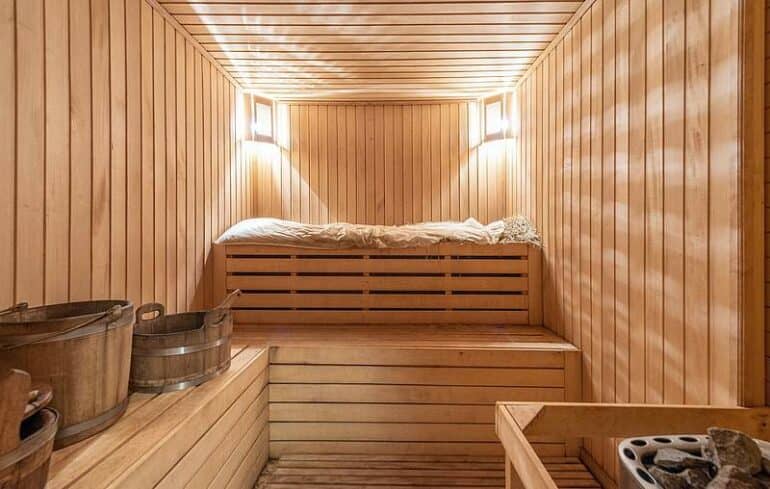Where is the warmest place in a sauna?
The sauna heater, usually made of metal and equipped with the sauna stones, generates the heat in a Finnish sauna. As the heater heats up, it radiates heat into the air, creating the steamy, sauna-like atmosphere. The heat from the heater is then absorbed by the walls and ceiling of the sauna, creating a warm, comfortable environment.
But not all parts of the sauna are equal in terms of heat. The area closest to the heater is usually the warmest, while the temperature gradually decreases as you move further away from the heat source. This is because heat rises naturally, so the warmest air in the sauna is near the ceiling closest to the heater.
So if you want to enjoy the full warmth of the sauna, you should be near the heater. This allows you to get the most out of the benefits of the heat, such as improved circulation, relaxation, and natural cleansing. Just be careful not to get too close to the heater, as it can get dangerously hot.
Different temperatures on sauna benches
When you enter a sauna, you often notice that the temperature varies depending on the height of the sauna bench. In fact, sauna benches have different temperature ranges, which contributes to a varied sauna experience.
In a traditional Finnish sauna, the upper benches are usually the hottest. As the warm air rises, the heat accumulates near the ceiling, and therefore the upper benches are the warmest. These areas are preferred by those who seek intense heat and want to enjoy the full sauna experience.
The middle benches of a sauna usually offer a more moderate temperature. They provide comfortable warmth and are a popular choice for those who like things a little more moderate. The middle benches are ideal for relaxing, sweating, and enjoying the positive effects of sauna heat without being overwhelmed by overly intense heat.
The lower benches of a sauna are usually the coolest. As the cold air sinks downward, the lower benches are slightly cooler than the upper benches. These areas are good for people who like it a little milder or want to take a short recovery break from the upper benches. The lower benches are also good for sauna newcomers who want to get used to the heat slowly.
The different temperature ranges of the sauna benches offer sauna-goers flexibility and the ability to adjust the heat according to their preferences. Everyone can choose the seating position that suits their comfort and needs.
The exact temperature on the sauna benches can vary from sauna to sauna, and also depends on the position in the sauna. In addition, personal preferences and individual sensations may cause the temperature to be perceived differently.
Safe sauna enjoyment
While saunas offer a number of health and wellness benefits, it’s important to use them safely. Here are some tips for safe sauna use:
- Before and after sauna use, it is important to drink plenty of water, as the body can lose up to 1.5 liters of fluid during this activity, which can lead to dehydration.
- Don’t stay in the sauna too long. Most experts recommend limiting your sauna session to 15–20 minutes. This allows you to enjoy the benefits of the heat without overdoing it.
- Avoid alcohol before or after your sauna session. Alcohol can interfere with the body’s natural ability to regulate its temperature, making it harder to survive unscathed in the heat of the sauna.
- Take it slow. If it’s your first time in the sauna, start with a shorter sauna session and increase the duration over time. This will help your body get used to the heat and avoid unpleasant side effects.
- Listen to your body. If you feel dizzy, lightheaded or uncomfortable in the sauna, listen to your body and take a break. When it comes to your health and safety, it’s always better to be safe than sorry.
The benefits of sauna heat
Sauna baths have been used for centuries for their positive effects on health and well-being. In addition to being a warm and relaxing environment, the heat of a sauna provides a number of benefits for the body and mind.
One of the main benefits of sauna heat is the improvement of blood circulation. As the body heats up in the sauna, blood vessels dilate, allowing blood to flow more easily throughout the body. This can help reduce the risk of heart disease and improve overall cardiovascular health.
The heat of the sauna can also help relieve muscle tension and pain. As muscles relax in the warm environment, stiffness, and soreness can be reduced. This can be especially beneficial for athletes or people with chronic pain.
The warmth of the sauna can also have a positive effect on mood. The warmth and relaxation of the sauna can help reduce stress and anxiety and provide a sense of calm and well-being. This can be especially helpful for people struggling with mental health issues such as depression or anxiety.

